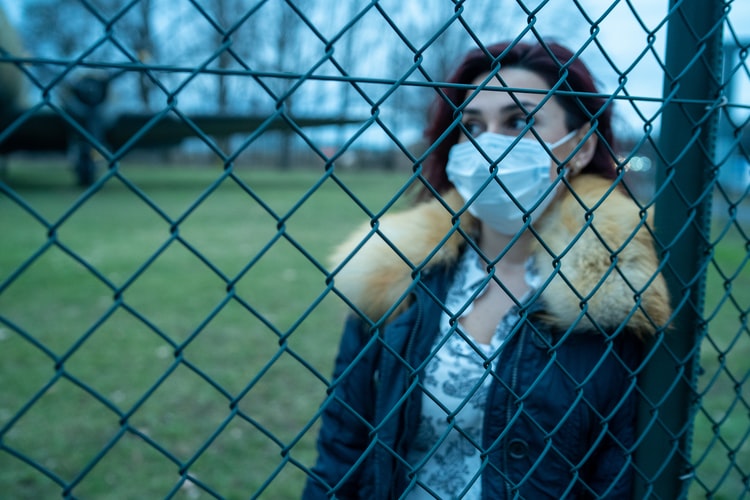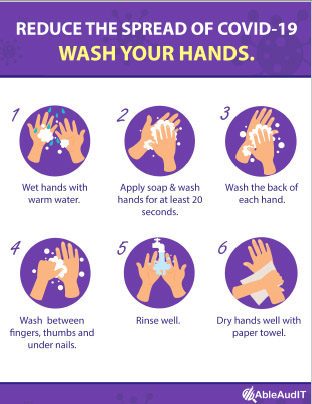
COVID-19 Coronavirus: Preparing Your Workplace
What is the current status of the coronavirus?
This document will discuss general precautions a workplace can take to help lower the spread of coronaviruses. For updates on the 2019-n-CoV/COVID-19 situation, please see:
- In Canada: Government of Canada (Public Health Agency of Canada) – Novel Coronavirus infection (Wuhan, China): Outbreak update
- In the USA: Center for Disease Control and Prevention (CDC) – 2019 Novel Coronavirus, Wuhan, China
- For world reports: World Health Organization – Novel Coronavirus (2019-nCoV)
How COVID-19 spreads
When someone who has COVID-19 coughs or exhales they release droplets of infected fluid. Most of these droplets fall on nearby surfaces and objects – such as desks, tables or telephones. People could catch COVID-19 by touching contaminated surfaces or objects – and then touching their eyes, nose or mouth. If they are standing within one meter of a person with COVID-19 they can catch it by breathing in droplets coughed out or exhaled by them. In other words, COVID-19 spreads in a similar way to flu.
Most persons infected with COVID-19 experience mild symptoms and recover. However, some go on to experience more serious illness and may require hospital care. Risk of serious illness rises with age: people over 40 seem to be more vulnerable than those under 40. People with weakened immune systems and people with conditions such as diabetes, heart and lung disease are also more vulnerable to serious illness.
Simple ways to prevent the spread of COVID-19 in your workplace
The low-cost measures below will help prevent the spread of infections in your workplace, such as colds, flu and stomach bugs, and protect your customers, contractors and employees.
Employers should start doing these things now, even if COVID-19 has not arrived in the communities where they operate. They can already reduce working days lost due to illness and stop or slow the spread of COVID-19 if it arrives at one of your workplaces.
Make sure your workplaces are clean and hygienic
- Surfaces (e.g. desks and tables) and objects (e.g. telephones, keyboards) need to be wiped with disinfectant regularly
- Provide information to employees and customers on proper hand washing techniques (see our new handwashing poster)
- Why? Because contamination on surfaces touched by employees and customers is one of the main ways that COVID-19 spreads
Hazard Prevention Program
Supporting the Internal Responsibility System, the employer should make all revisions to the workplace Hazard Prevention Program by consulting with:
- the policy health and safety committee
- the workplace health and safety committee, or
- the workplace health and safety representative
Federal employees must be provided with training on the hazard and the safe work procedures that will protect them. Employers must keep training records.
Able Audit Resources
Special Program: To help businesses during this crisis, we are providing access to a free license including resources for COVID-19 Coronavirus program and cleaning.
- COVID-19 Coronavirus: Preparing Your Workplace (WHO)
- COVID-19 Coronavirus: Events and Meetings (WHO)
- COVID-19 Coronavirus: Workplace Travel
- Checklist: Cleaning – Facility (COVID-19)
- Cleaning – Restaurant (COVID-19)
Please See Additional Resources Below
| Source | Description | Resource/Link |
| World Health Orgnaization (WHO) | Coronavirus disease (COVID-2019) situation reports | Situation Reports |
| World Health Orgnaization (WHO) | The WHO has guidelines for workplaces to get ready for COVID-19. | Get ready for COVID-19. |
| The U.S. Department of Labor’s Occupational Safety and Health Administration (OSHA) | The document provides practical guidance for preventing the spread of COVID-19. to help companies respond in the event of coronavirus in the workplace. The guidance was developed in collaboration with the U.S. Department of Health & Human Services (HHS). | 2020 Guidance on Preparing Workplaces for COVID-19 |
| Coronavirus disease (COVID-19) – Employment and Social Development Canada | There may be concerns from employers and employees in Canadian federally regulated workplaces about coronavirus and questions about how to prevent exposure in their workplaces. | Coronavirus disease (COVID-19) – Employment and Social Development Canada |
| Centers for Disease Control and Prevention | Front-line healthcare personnel in the United States should be prepared to evaluate patients for coronavirus disease 2019 (COVID-19). The following checklist highlights key steps for healthcare personnel in preparation for transport and arrival of patients with confirmed or possible COVID-19. | Healthcare Personnel Preparedness Checklist for COVID-19 pdf icon[PDF] |
| Centers for Disease Control and Prevention | All U.S. hospitals should be prepared for the possible arrival of patients with Coronavirus Disease | Coronavirus Disease 2019 (COVID-19) Hospital Preparedness Tool pdf icon [2 pages] |
| Centers for Disease Control and Prevention | The CDC has interim guidance for what employers can do to respond to coronavirus. | Interim guidance for what employers can do to respond to coronavirus. |
| Centers for Disease Control and Prevention | A checklist for employers to prepare for pandemic influenza planning. | Pandemic Influenza Planning. |
| Tthe Department of Health and Human Services (HHS) and the Centers for Disease Control and Prevention (CDC) | In the event of pandemic influenza, businesses will play a key role in protecting employees’ health and safety as well as limiting the negative impact to the economy and society. Planning for pandemic influenza is critical. To assist you in your efforts, the Department of Health and Human Services (HHS) and the Centers for Disease Control and Prevention (CDC) have developed the following checklist for large businesses. It identifies important, specific activities large businesses can do now to prepare, many of which will also help you in other emergencies. Further information can be found at www.pandemicflu.gov and www.cdc.gov/business. | Business Pandemic Influenza Planning Checklist |
| The National Restaurant Association. | Guidelines for coronavirus and what restaurants can do. | What restaurants can do. |
Learn more about how our safety management software features can you help your JHSC perform and manage inspections, distribute reports, assign action items, develop safe work procedures, perform safety talks, committee meeting minutes and incident reports.


